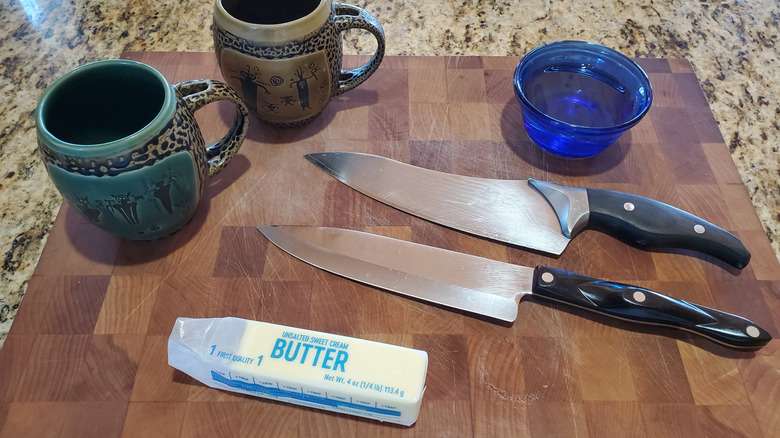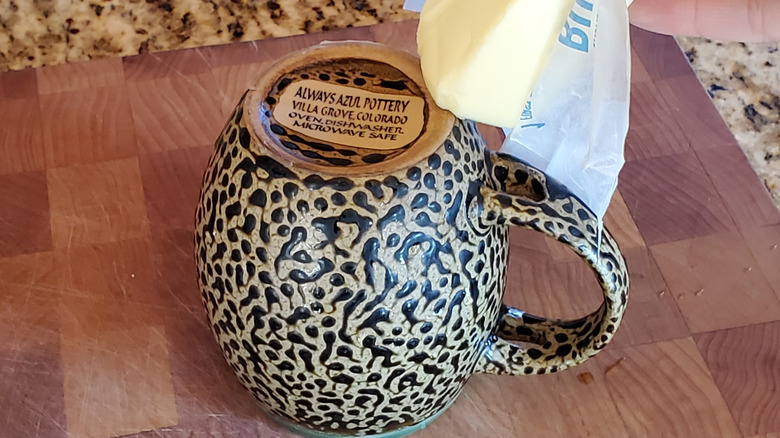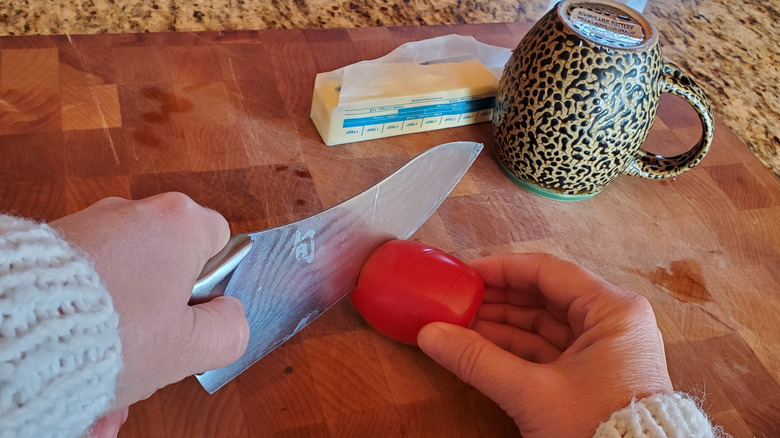Can You Sharpen A Knife With Butter And A Ceramic Mug? This Hack Is A Smooth One
Can this knife cut a tomato? Blade versus tomato is a common test for whether a knife is nice and sharp, and my trusty chef's knives have not been cutting the mustard lately. Well, cutting tomatoes is more like it. My family is kind of lazy about using the honing rod we have, and our knives were not at all up to the tomato test. Luckily, all you may need to get your knife looking brand new again is a handy mug from your kitchen cupboard. This hack involves flipping the mug over and running both edges of the blade over the unglazed base a handful of times. Your underwhelming knife should be up to real slicing tasks, right?
Some have gone as far as to add butter to this hack. According to knife experts, ceramic rods are meant to hone rather than sharpen a blade, so it seems logical that a ceramic mug will do the same. Using a lubricant while honing or sharpening knives is meant to keep the blade cool during the process. A liquid like water or oil protects the blade from heat damage caused by friction between the metal and the honing tool. Since butter improves nearly everything edible, perhaps it could also improve contact between the ceramic mug and the blade. Would it be worth it to compare two dull blades after the mug treatment, one sharpened with the help of butter and the other with water? It was worth a try.
Materials and setup
My husband is a skilled cook, and we own a couple of high-quality chef's knives for making swoon-worthy meals. As I mentioned, we are lazy, but we're also busy, so these superb cutting tools are rarely slicing up to their potential. To get a baseline, I sliced the tomato with both knives. Both of them pressed into the fruit's flesh without cutting. Although comparing two knives of differing makes and dullness levels isn't the best basis for testing, it still could show me whether a butter-enhanced mug aids in honing a blade. Two knives, two mugs, and two different lubricants were on hand for my honing experiment.
Full of caffeine-fueled impatience, I applied butter to the mug's base and gave the blade a few swipes on the surface. Even after this slapdash job, the knife sliced the tomato noticeably better than before. Still, it was hardly passing effortlessly through the fruit — I should probably consider learning how to sharpen a knife like a chef at some point. I reviewed the proper steps and did a thorough job this time. I added more butter to the mug base and followed the proper steps for honing a blade. After 20 slow strokes on each side of the full length of the blade, held carefully at 20 degrees, it didn't surprise me that the knife sliced through the tomato beautifully. But did the butter truly help at all?
Test time
Intent on doing this experiment as well as possible, I shifted my focus to our second-best knife. This guy was going to get just a water treatment. I wet the base of the second mug and went through the proper process. Lo and behold, this knife also handled tomato slicing much, much better than before. I had to be honest with myself, though — comparing two nonidentical knives in a butter-versus-water lubricant contest wasn't really scientific.
Nevertheless, I was content that the mug trick worked, no matter which lubricant I chose. As long as I had a ceramic cup nearby, I could make kitchen knives workable. Although not everyone uses a lubricant when honing or sharpening a kitchen knife, I liked the idea that it could extend the life of our costly chopping tools by keeping the blade cool. Most sources say that honing doesn't remove material from your blade like sharpening does, I did notice some residue on my sliced tomato after not wiping my post-honed knife before cutting. Luckily, a wipe or rinse to either your knife or cut food can take care of whatever's left over after honing. But in the future, I'd clean the blade before slicing food.
The verdict is in
All in all, I came away with two blades greatly improved by a mug-bottom honing hack. I can feel future frustration in the kitchen melt away. If keeping the blade cool during the process helps prolong the life of the knife, I'll do it. But I prefer to do it for as little cost as possible. Had I noticed a drastic difference between the water-lubed and butter-lubed mug honing jobs, I'd think differently. However, I'll gladly save our butter supply for a batch of my husband's pancakes.
My less than scientifically accurate experiment leaves questions, of course: Would a different type of mug yield different results? (I used the same kind for both blades.) How would two of the same type of knife fare when comparing water versus butter as lubricants? Truly, it doesn't matter to me. I'm just happy to slice my tomatoes with ease and little or no cost.



